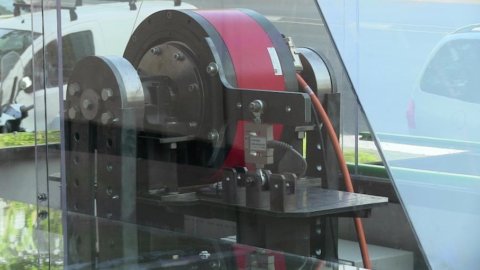ENEA presented in Rome a smart and low cost technology for produce energy from sea waves: this is the PEWEC device (Pendulum Wave Energy Converter), designed for the Italian coasts, where the waves are of low height and high frequency. It consists of a floating system very similar to a raft to be positioned in the open sea, capable of producing electricity by exploiting the oscillation of the hull due to the effect of the waves.
The prototype on display only today in front of the ENEA headquarters in Rome is on a 1:12 scale, weighs 3 tons, measures 3m x 2m x 2m in height and it is the fruit of collaboration with the Turin Polytechnic, as part of the program agreement between the Ministry of Economic Development and ENEA on Research into the Electric System. But the final version of the power plant-raft will be much larger: ENEA and the Turin Polytechnic are already working on the design of the device on a 1:1 scale, with a nominal power of 400 kW.
"This low-cost system of energy production from the sea is particularly interesting for the many Italian islands, where the energy supply is guaranteed by expensive and polluting diesel power plants," said Gianmaria Sannino, head of the ENEA climate modeling and environmental impact laboratory. . “A dozen of these devices – he added – can produce electricity for a town of 3.000 inhabitants, also significantly contributing to countering erosion phenomena by reducing the energy of the waves that break on the coast, without significantly impacting the marine flora and fauna.”
Lhe exploitation of energy from waves has several advantages even compared to wind and photovoltaics: a low environmental and visual impact, a lower hourly and daily variability and a favorable seasonal variation, given that the potential of energy from waves is higher in winter when energy consumption is maximum.
“In Italy – underlined Sannino – interest in the production of clean and renewable energy from waves and tides is growing and according to the National Action Plan for Renewable Energy we should install a power of 3 MW of this type of plant within 2020. Marine energy represents a real opportunity to foster economic growth and employment, improve the security of energy supply and, above all, increase competitiveness through technological innovation.”
But exploiting the energy of the sea means knowing in detail the speed of the currents, the height of the waves and the intensity of the tides: this is why ENEA has created "The Atlas of the Mediterranean Wave Climate”, the first map capable of accurately identifying the most interesting areas for the energy exploitation of waves.
“With his 8.000 km of coastline – concluded Sannino – Italy has an important energy potential associated with wave motion, comparable to that present on the eastern coasts of the North Sea. The western coast of Sardinia, for example, has an average annual energy flow value of about 13 kW/metre, while that of the north-west of Sicily is around 10 kW/metre”.
In addition to this mapping, ENEA has created a new operating system for forecasting waves up to five days, capable of estimating the energy to be fed into the electricity grid with a spatial detail of a few hundred metres.
At European level, ENEA participates in the joint research program on energy from the sea JP Marine Renewable Energy, proposed by the European Energy Research Alliance (EERA). The exploitation of energy from the sea is among the priorities of the European Commission for the development of the Blue Economy: an action plan was presented for 2014-2020 with the aim of reaching an installed power of 3,6 GW by 2020 and of 188 GW by 2050.
Attachments: Download the video showing how Pewec works





